Abu Dhabi: World’s richest city per capita is more than just skyscrapers, opulence, shopping and tourists
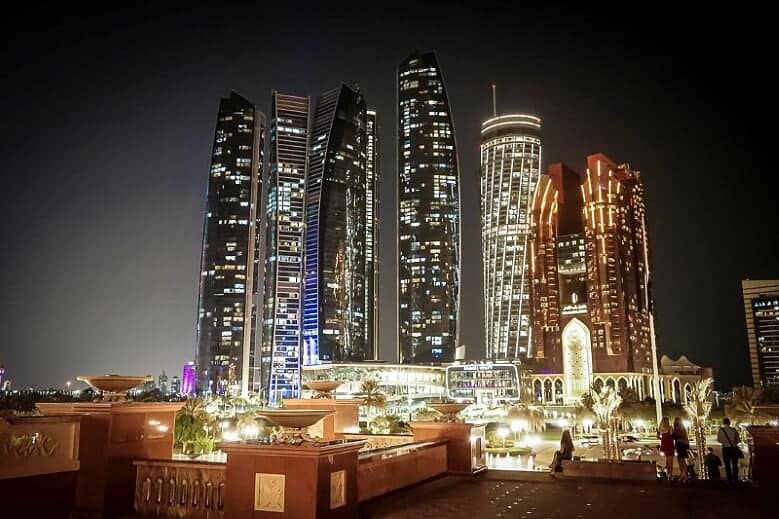
ABU DHABI, United Arab Emirates — I don’t believe time machines will ever exist but I came the closest to experiencing one.
I just traveled from one of the oldest cities in the world to one of the newest.
Flying six hours from Rome (founded 753 B.C.) to Abu Dhabi (founded 1971), I felt like I walked out of the Roman Forum to some megalopolis in a science fiction novel.
The best perspective is from street level. Look up from one of Rome’s cobblestone roads and you see 2,000-year-old monuments and churches and arenas of war, places where they shed blood and tears long gone dry. Look up from one of Abu Dhabi’s spotless eight-lane boulevards and you see skyscrapers that block the sun and cranes building one taller than the last one.
Whoop! Look! There it is: another 85-story building just completed. What’s in it? Chances are there’s an observation deck like the one we stood in with a view of the richest city per capita in the world.


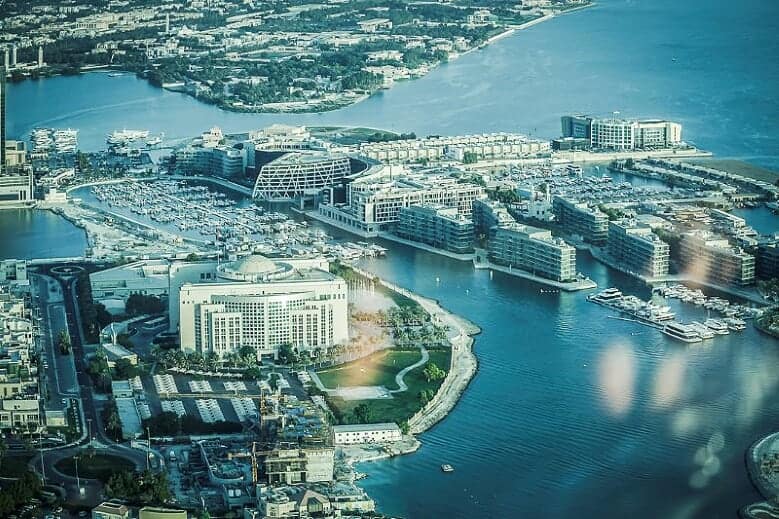
The Observation Deck at 300, the DUH!-llest title in the Middle East, is named for being 300 meters high. It’s in the Jumeirah, one of the three sky-reaching Etihad Towers that crowd the far west end of town like giant matchsticks on their ends. Marina and I paid the 55 dirhams (about $15) each for the elevator ride 74 floors up, declining the 95 ($25) which includes a table.
The huge deck is lined with round tables and plush leather chairs pushed against floor to ceiling windows. I don’t know if we were more awed by the view or the 35 dirhams ($9.50) for a donut, cookie or muffin and 65 dirhams ($18) for a panino. We looked out and down — WAY down! — and saw what all the world fuss is about this city.
Abu Dhabi is built on an archipelago with skyscrapers clustered in what looks like a Middle East version of downtown Chicago. The Jumeirah is one of three side-by-side Etihad Towers but the other two can’t block the view of Burj Mohammed Bin Rashid, the 92-floor downtown office tower that’s part of the World Trade Center and is Abu Dhabi’s tallest building.
Where there aren’t skyscrapers there are luxury apartment and office buildings on former sandbars dotting the sky blue lagoons and Persian Gulf beyond. This is when Abu Dhabi’s advances hit me. These sandbars are what made up much of Abu Dhabi just 50 years ago.
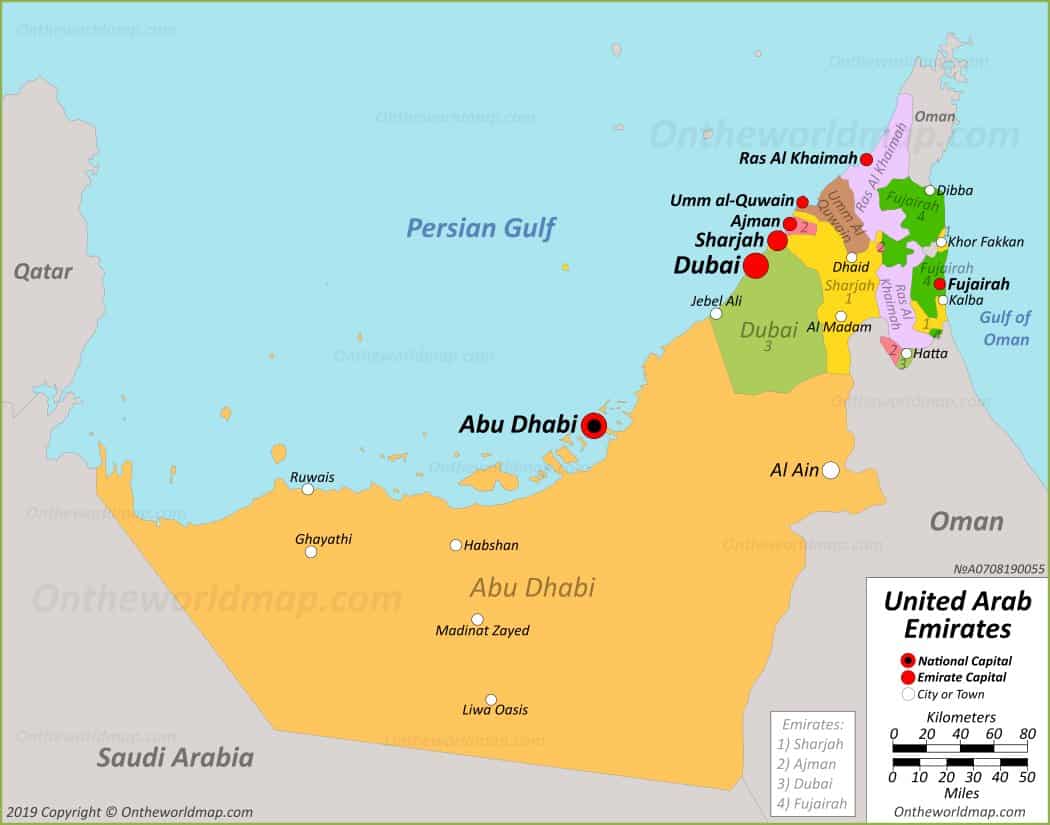
Abu Dhabi was once a world pearl center. Locals dove up to 30 times a day for pearls and were paid only at season’s end. By the 1930s, the pearl trade had faltered and the British started exploring rumors of oil reserves. They signed treaties with the Arab Peninsula’s emirs as part of the Trucial Coast then everything changed. Oil was discovered in Abu Dhabi in 1960. In 1968, with the Middle East exploding in turmoil, the British announced their withdrawal from the Trucial States as part of their move to pull all troops east of the Suez. The United Arab Emirates formed in 1971 with Abu Dhabi (pop. 1.3 million) as its capital and Dubai (3.1 million) as its overrated commercial center, which I’ll explain in next week’s blog.
In 50 years, in one of mankind’s greatest civic achievements, Abu Dhabi has gone from a struggling pearl center to the pearl of the Middle East. It is one of seven emirates, territories run by emirs, that make up the UAE. The UAE is the size of Idaho yet has 6 percent of the world’s oil reserves. Its crown prince, 70-year-old Mohammed bin Zayed Al Nahyan, the son of founder Sheikh Zayed, is considered the world’s richest man with an estimated worth of $1.3 trillion. Think about that. It’s way north of $999 billion. He could buy 4.6 million Lamborghinis.
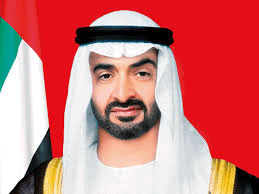
He’s not alone. He’s just the richest. According to Fortune magazine, in 2007, Abu Dhabi’s 420,000 UAE citizens were worth $17 million each and had invested $1 trillion abroad.
However, looking around, we saw the observation deck represented a rough demographics of the true UAE. We heard American English, British English, German, French and Hindi. We saw one local couple, a tall, distinguished man with a red-and-white-checked keffiyeh headscarf, and his wife in a long white robe and hajib headscarf. They sipped fruit juice out of elegant wine glasses and nibbled sweets off a three-tier dessert tray.

That figures. The UAE has 9 million residents. Only 1 million are citizens. The others have poured in from around the world to work in the construction and tourism fields which seem to grow more every year. In fact, two years ago the 260,000-square-foot Louvre Abu Dhabi opened at a cost of $660 million.
In our first night, our cab driver from the airport was from Kenya, our waiter was from the Ukraine, our cab driver back to the hotel was from India, our cocktail waitress at our outdoor bar was from the Philippines and the cashier was from Sri Lanka.
I asked our hotel concierge how to say “How much?” in Arabic and he said, “I don’t know.”
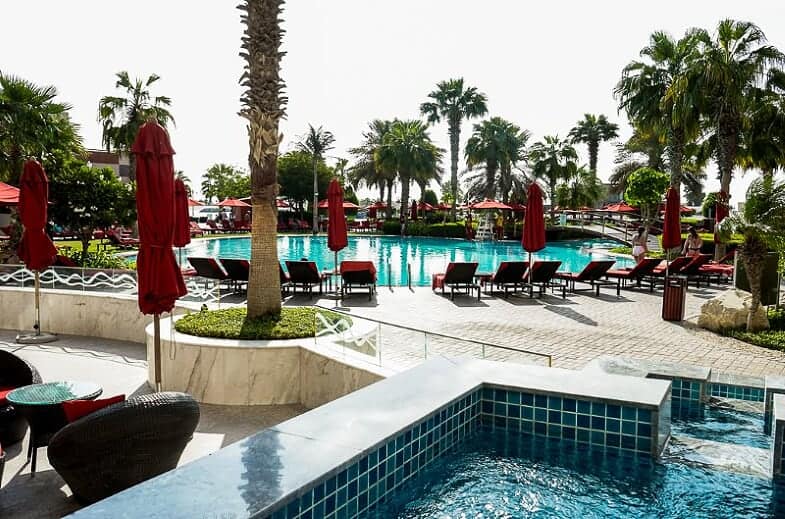
Marina and I never had the UAE on our bucket list. When I thought of Dubai I always thought of the world’s biggest airline connection hub to Asia and Australia and movie scenes of men dangling from skyscrapers. But Marina found a deal on Abu Dhabi’s 5 ½-star Khalidiya Palace Resort for 520 euros (about $575) for four nights. That’s a steal considering our Vegas-style swimming pool next to a sandy beach on the shores of the Persian Gulf, big room with fully stocked mini bar and fantastic spa with Jacuzzi, steamroom and sauna. At night we sat at the outdoor bar under lit palm trees or next to the sand in comfy bean-bag chairs. We sipped thick, natural fruit juices of pomegranate and mango while musicians played soft Arabic music.
My fear of visiting the UAE was the Muslim culture, which I found appealing through my visits to 12 Islamic countries, would be swallowed up by Western commercialization. In Dubai, it’s true. It’s an Islamic Water World. But in the shadows of Abu Dhabi’s skyscrapers I found patches of culture that haven’t changed in decades.
We spent our first meal after landing at Tashas Cafe. It’s considered one of THE local hangouts in Abu Dhabi. It’s an airy restaurant with an expansive patio area where we sat next to back-lit cactus plants with views of the Qasr Al Watan, the presidential palace of white granite and limestone that just opened to the public this year. In the distance, we could see the soft blue lights of the Sheikh Zayed Grand Mosque, which earned my vote as the most beautiful mosque in the world.
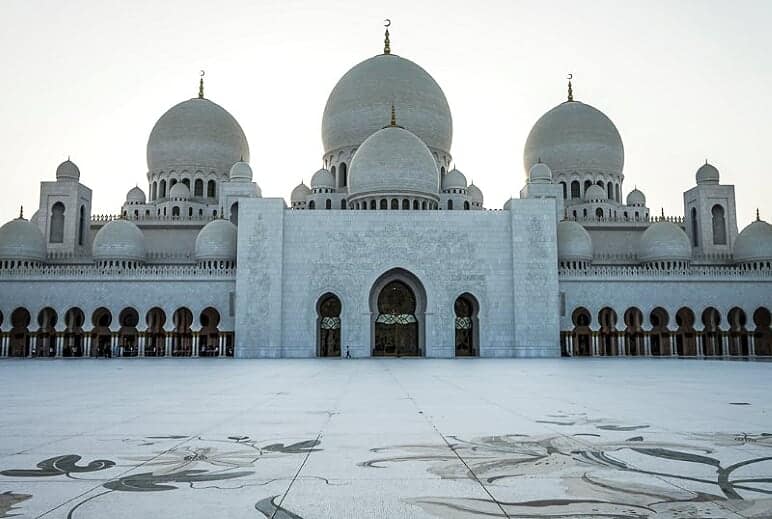
My parmesan and couscous-crusted chicken was massive, with two slabs of delicately breaded chicken for a price of 97 dirhams (about $25). With a thick banana shake, as good as any I’ve had in the States, it wasn’t a bad start to a real good gastronomic weekend.
Sitting around us was an array of locals, all dressed in white robes and keffiyehs with female companions in black hajibs. Two teen-agers next to us drank fruit juice in white robes and ballcaps. Our 30ish Ukraine waiter had first worked in Dubai, UAE’s party and tourist central.
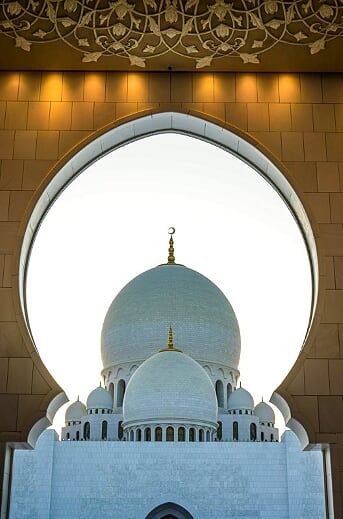
“It was like seven Fridays in a week,” he said. “Every day was Friday. I kept feeling like a tourist.”
Abu Dhabi has a definite Muslim feel and not just because it’s nearly impossible to get a drink. Yes, while alcohol flows in the hotels and nightclubs of Dubai, alcohol in Abu Dhabi is as rare as pornography. Our hotel didn’t have it. The grocery stores didn’t have it. The restaurants didn’t have it. The InterContinental hotel has a place not-so-subtly named the Belgian Beer Cafe but my alcohol withdrawal never gnawed at me enough to rub elbows with a thirsty German banker.
Instead, we spent our second night in one of the holiest places of my life. I’ve been to beautiful mosques all over the world. The Blue Mosque in Istanbul. The Omar Ali Saifuddien in Brunei. The Mohammad Al-Amin in Beirut. They dominate skylines in the day and light up the sky at night. But they are all Sunday school classrooms compared to the Sheikh Zayed Grand Mosque.
We passed it on the airport road and it looks more like a small city than any place of worship. Started in 1996 and not completed until 2007, it is 420 meters long and 290 meters wide. You could fit four football fields and have enough room for a couple of basketball courts. It consists of 90,000 tons of white marble framed by four 107-meter minarets. More than 1,000 pillars, all lined with gold leaf, support 80 marble domes. This giant white confection when lit up at night looks like the world’s largest birthday cake.

It’s open to the public except during prayer times, but it has more security than Beirut Airport. We had to fill out an ID registration form before entering a massive underground network of long, roped lines that zigzagged through huge brightly lit corridors. The lines were filled with people from around the world. Marina, who was modestly dressed all weekend and wore a long dress with a headscarf to the mosque, was given a long blue, hooded robe that also covered her shoulders. It’s as form fitting and flattering as a giant potato sack. She looked like a female hobbit. We had to pass through another security clearance before climbing a long flight of stairs to the entrance.
When we emerged, the sun had started to set. The soft light bounced off the white marble facing like lightning. The mosque is massive, the largest I’ve ever seen. Yet the attention to detail is so delicate. After we passed long, shallow pools with navy and turquoise tile, we approached the building and took a close look at the marble. The builders carved intricate floral designs and added stones such as red agate, abalone, jasper and mother-of-pearl.
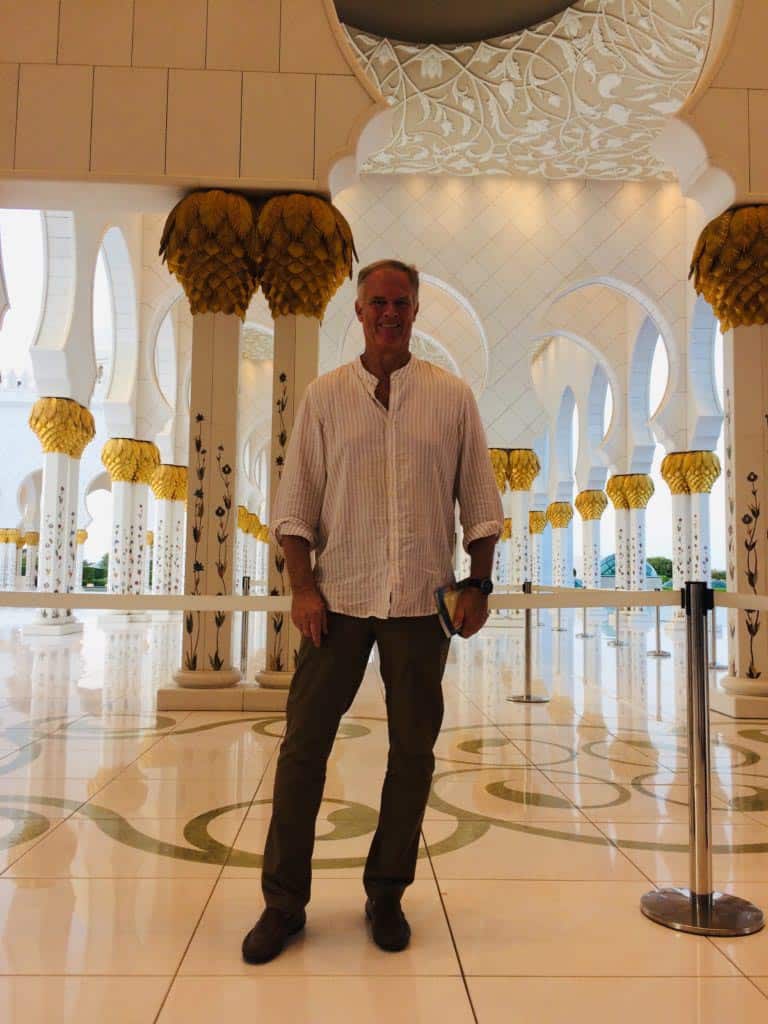
I remember seeing similar artistry on the Taj Mahal.
We entered the giant keyhole of a door frame and could smell fresh lemons and hear the feint sounds of a prayer from the adjourning prayer hall. We stood under a hallway filled with a forest of white and gold-wrapped columns. Local worshippers filed out past us, shoes in hand.
We joined another long line that wrapped around the huge open courtyard that can accommodate 50,000 worshippers. White-robed guards with security badges stood guard keeping any visitors entering the massive expanse for a selfie or photos of the minarets, with light from the sinking sun twinkling off the towers.
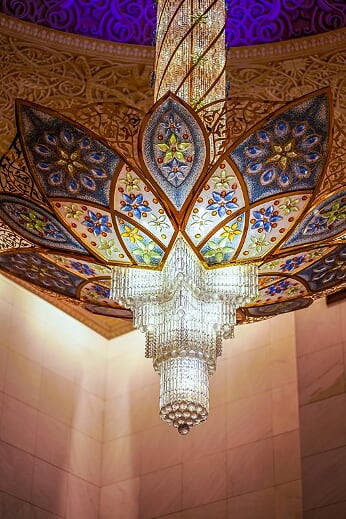
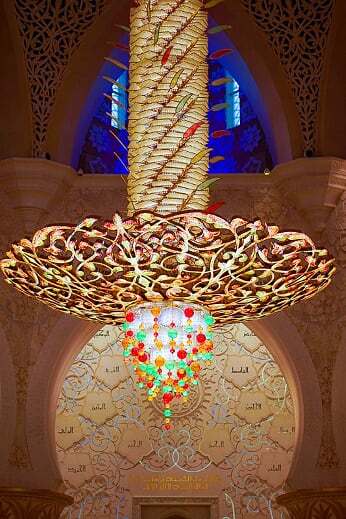 We made our way into the gargantuan prayer hall. Hanging above us were three huge blue, yellow and green chandeliers, the largest weighing 11 tons and sprinkled with Swarovski crystals and 40 kilograms of 240-karat gold. It looked like the world’s most expensive Christmas tree hanging upside down.
We made our way into the gargantuan prayer hall. Hanging above us were three huge blue, yellow and green chandeliers, the largest weighing 11 tons and sprinkled with Swarovski crystals and 40 kilograms of 240-karat gold. It looked like the world’s most expensive Christmas tree hanging upside down.
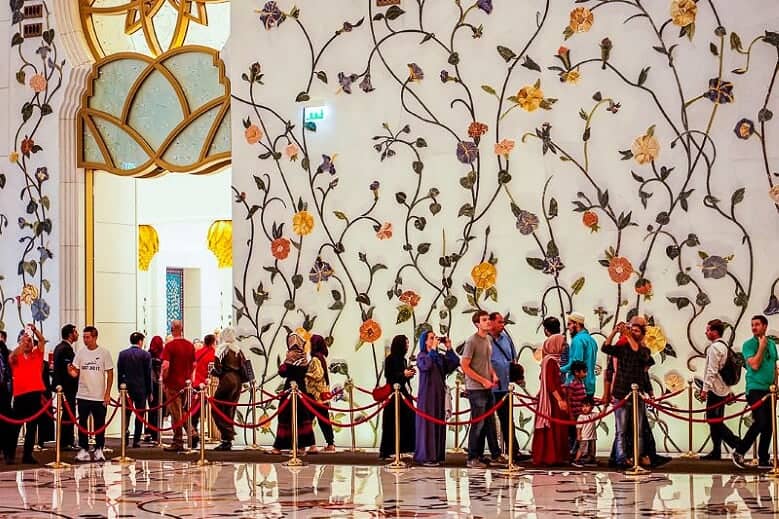
We stood on the world’s largest loomed carpet made from Iranian cotton and New Zealand wool flown in from Iran on two airplanes. To cover the 5,700-square-meter prayer hall, it took 1,200 people two years. It took one year just for them to hand knot the beige and green wool thread on the cotton base which wound up totaling 2.27 billion knots.
As we exited, the sun had set and the golden lights from inside illuminated all the archways like a string of giant pumpkins. With the quiet murmur of the mesmerized masses and the long, Muslim prayer filling the air, it felt outrageously romantic. I wanted to hug Marina, even in her formless prison gown. I didn’t touch her. We knew that public displays of affection are frowned upon if not outright illegal.
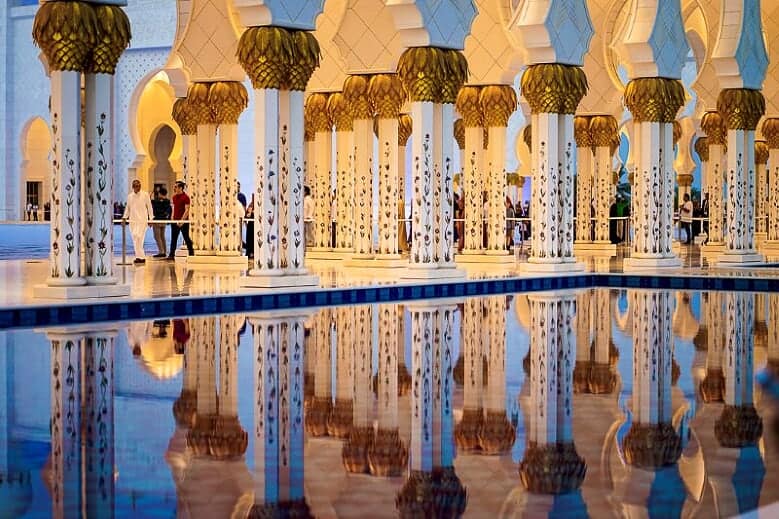
However, make no mistake about it. Despite its mores, Abu Dhabi is very romantic. The soft sway of ever-present palm trees. Spectacular landscape views from skyscrapers above and skyline views from streets below. Late-night swims in temperatures in the high 70s. But the heart beats nowhere harder in Abu Dhabi than at BBQ Al Qasr.
It’s considered one of the most romantic restaurants in the Middle East and through 106 countries, 18 with Marina, I found it may be the most romantic I’ve ever experienced. BBQ Al Qasr is in the Emirates Palace, which only looks and sounds like the Crown Prince’s home. It isn’t.

It’s a hotel.
Across the wide boulevard from our hotel, the Emirates Palace covers 200 acres with 114 domes, more than 1,000 crystal chandeliers and 392 luxury rooms. At $3.9 billion, it was the world’s third most expensive hotel when it was completed in 2005. We walked into the lobby and found ourselves looking straight up at the floors, all lit in golden light like a giant jewel box. Rooms go from $1,650 a night to $30,000. It’s practically a 10-euro cab ride from the entrance to the back exit where we headed to the restaurant.
BBQ Al Qasr is about as close to a BBQ joint as a Lamborghini is to a moped. Set off about 50 yards from the back of the hotel, it’s a series of gazebos surrounded by palm trees on the sand next to the water. We were alone. The gazebo was so softly lit the leather-bound menu came with a small adjustable light attached.
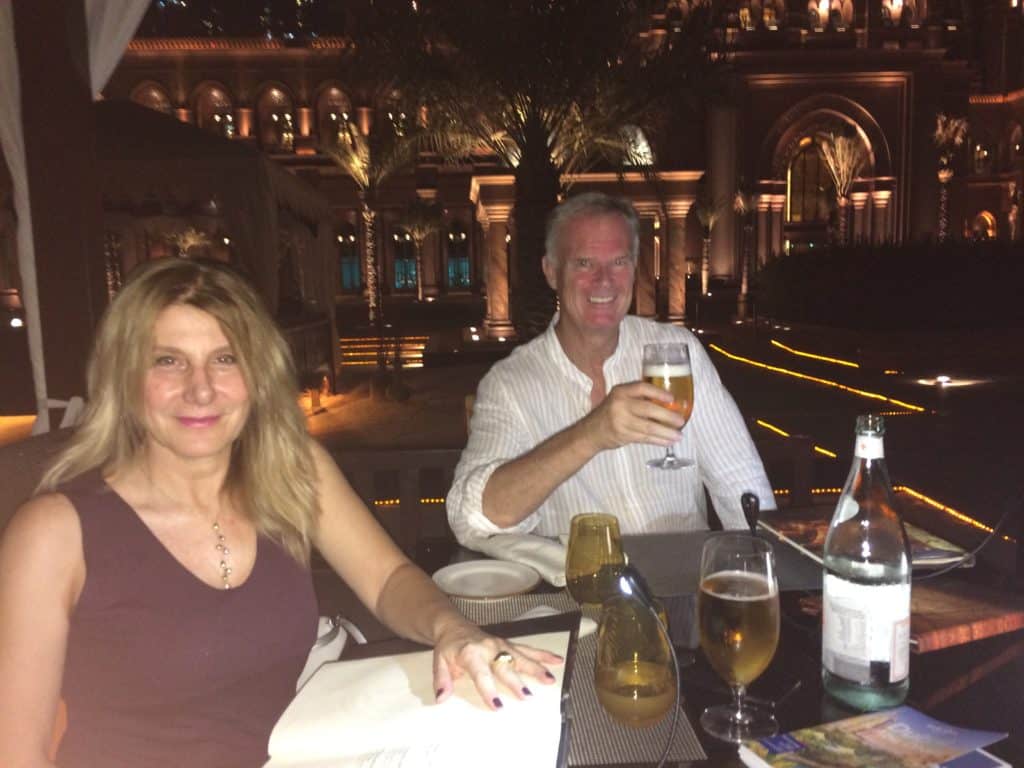
The only sounds we heard were birds chirping overhead and soft music piped over the sand. The water was as still as a warm lake. We could see the royal blue domes of the Presidential Palace in the distance. The Emirates Palace behind us was bathed in gold light. For two freelance journalists, this is the closest we’ll ever get to feel like royalty.
The food was worthy of a king, too. In my experience as a food writer, the better a restaurant’s views, the worse the food. Try any revolving restaurant atop a hotel and prove me wrong. At BBQ Al Qasr, they brought out a basket of fresh all-grain bread with spreads of butter, sun-dried tomato and olive. My huge chunk of fresh sea bass was chargrilled and covered in shrimp, couscous, roasted corn and a lobster butter sauce.
BBQ Al Qasr even had beer.
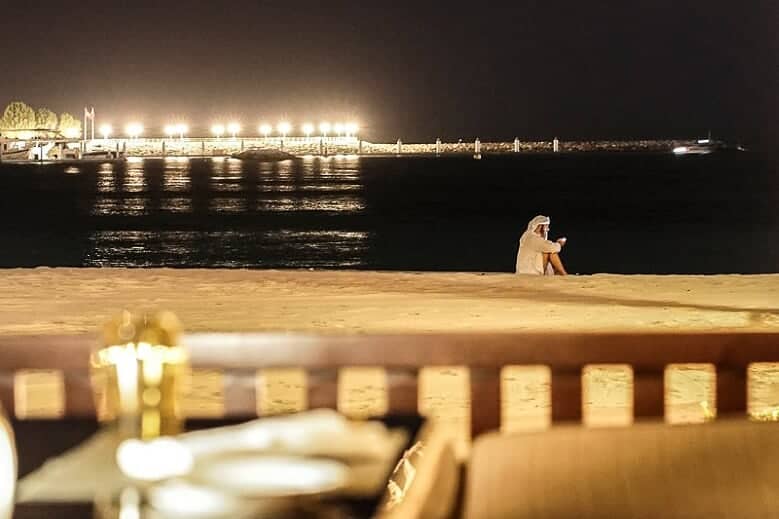
Expensive? Oh, you bet. The dinner for two was 683 dirhams, about $185. A small bottle of pedestrian Stella Atois was $11. But so what? Eating in your own private gazebo on the shores of the Persian Gulf is something from the end of a James Bond movie. You don’t think it could happen to you.
No, the UAE is not for budget travelers. However, one can travel cheaply. For a massive buffet breakfast, our hotel charged the larcenous price of 140 dirhams ($38), apparently the going rate in Abu Dhabi. Instead, we went to the supermarket Waitrose, which despite being in the basement of the luxurious Jumeirah, had cheaper prices than a Piggly Wiggly in rural Georgia. One time we wanted to eat dinner and breakfast in our room we bought roast chicken, milk, cereal, noodle soup, sausages, salad and biscuits for 51 dirhams (about 12 euros). They are not priced for tourists and natives. They’re priced for the 90 percent of the residents who are imported labor.

Transportation is dirt cheap. A bus pass cost only 50 cents and we could ride to most places in Abu Dhabi in a taxi for only $5-6. The 20-minute cab ride from the airport to our hotel was about $22. Our two-hour bus ride to Dubai was only $16 round trip. It’s like they built a futuristic society around a workforce it didn’t leave behind.
The cheapest activity to do in Abu Dhabi is strolling. It’s a remarkably walkable city. Unlike Dubai, which seems as crowded as any dusty Third World commercial center, Abu Dhabi is wide open. Clean, modern, six-lane boulevards had little traffic. Downtown sidewalks were spotless and never crowded. Shopping malls had only had a few locals perusing high-end stores. Abu Dhabi is to San Diego what Dubai is to L.A.

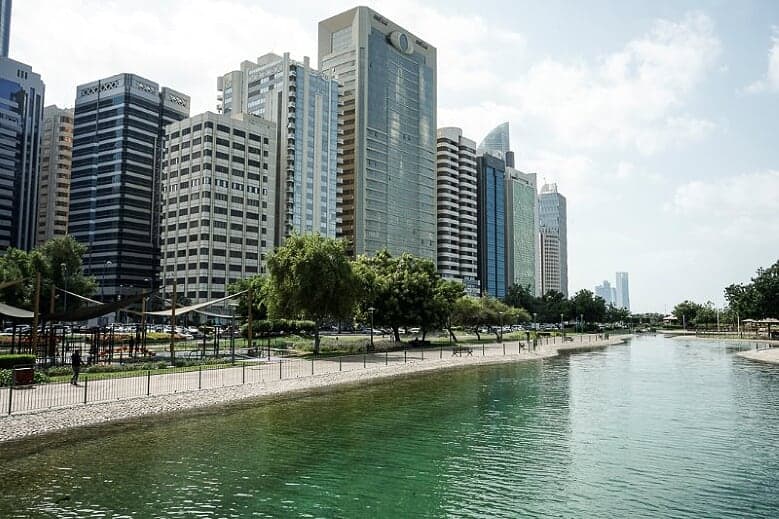
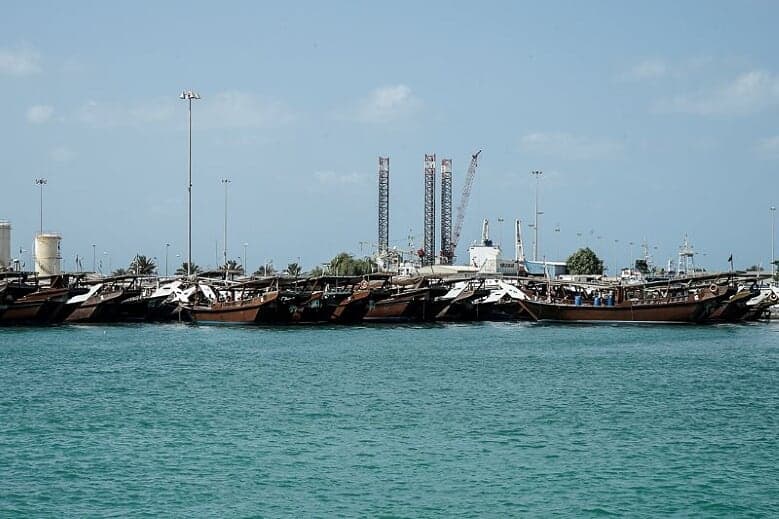
Abu Dhabi is most tranquil on the Corniche. It’s a seaboard that stretches five miles from the Emirates Palace all the way to the Al Mina harbor at the end of the shoreline. After one breakfast, Marina and I walked along the spotless brick walkway with Abu Dhabi’s skyline to our right and the Persian Gulf to our left.
Keeping to local mores, we resisted holding hands. We strolled like old friends in 93-degree heat and surprising 47-percent November humidity. We walked past a fountain shooting water 15 meters into the air. Stray, healthy-looking cats ate fresh fish in the shade. Geese and ducks floated languidly in the water. Purple flowers lined the roadside. It was a Saturday morning and we passed hardly anyone. Four Indian laborers rested on a bench.
Abu Dhabi is like being in a big, modern capital with a little country seaside village across the street.
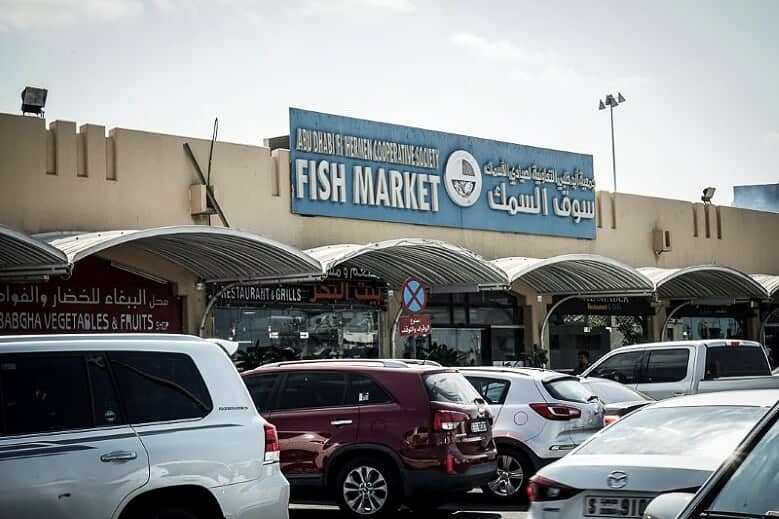
Near the end of the Corniche, past a long public beach closed for maintenance, we passed Heritage Park. It’s a long street of greenery with beautiful views across the river to a harbor lined with dhows, the ancient wooden boats that have been used for fishing since about 600 B.C. in China. They take tourists out on sunset cruises. Instead, we avoided the tourists and continued behind the harbor to the Al Mina Fish Market. It’s a big warehouse filled with stalls and burly men hawking their fish, all caught that day.
One man who called us over pointed to giant shrimp, sea bream, tilapia, and grouper. I also saw one stall lined, sadly, with baby sharks, no more than two feet long. Marina had to turn away in disgust.
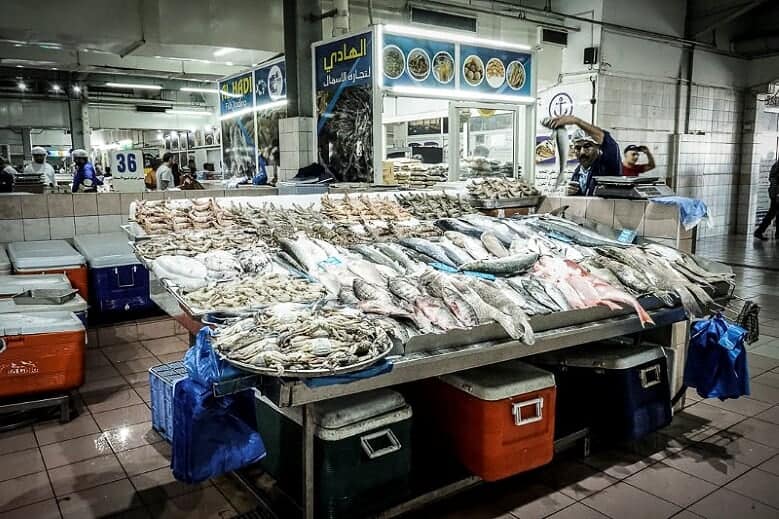
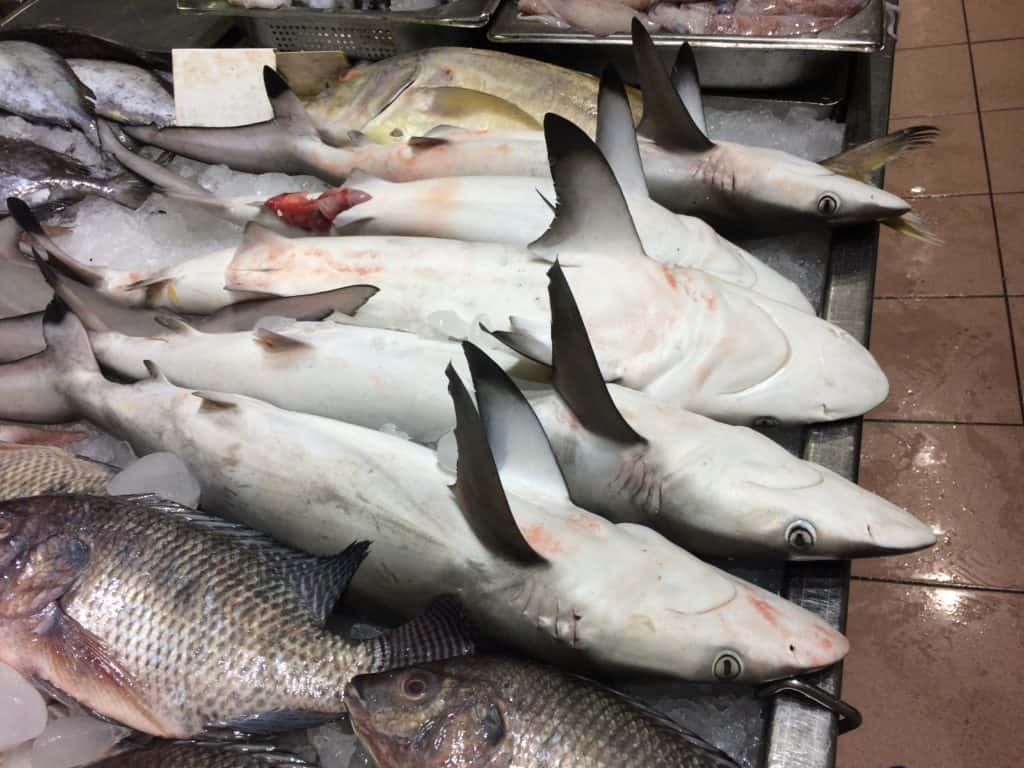
In one corner, men in hairnets with knives that looked like they once beheaded criminals carved up fish with pools of blood forming around their feet. The market had few customers.
We headed to a back corner and entered Blue Ocean Grill, a modest, family style restaurant with blue tables on a spotless white floor. It looked like it could be a chowder house on the Oregon Coast. The menu had everything from tandoori lobster for 95 dirhams (about $25) to seafood tagine for 45 (about $12). I had a fantastic grilled salmon on a bed of basmati rice with fresh vegetables and a fresh, thick pineapple juice. Lunch for two was all of about $44.
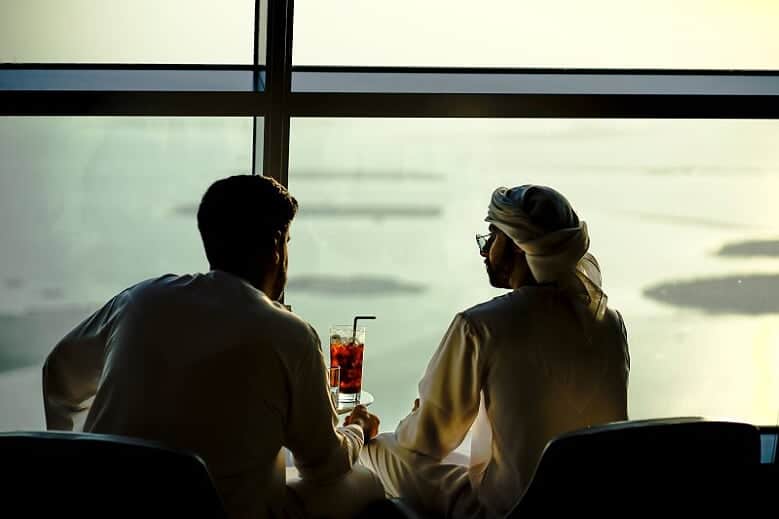
Abu Dhabi is definitely on our return list. It doesn’t have to be expensive and it is a slice of Islam that highlights all the positives and few of the negatives. Dubai? Unless we have a layover on a trip to Asia, we’ll skip it.
Stay tuned next week to find out why.


May 11, 2021 @ 3:02 pm
very beautiful country i never see
May 14, 2021 @ 3:38 am
Nice travalogue. Thanks as if I visited Abu Dhabi. My son works there and due to Covid 19 I couldnt visit.
I frequently visited Doha before Covid and stayed with my daughter there. That too a nice place.